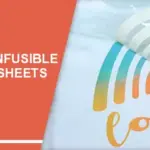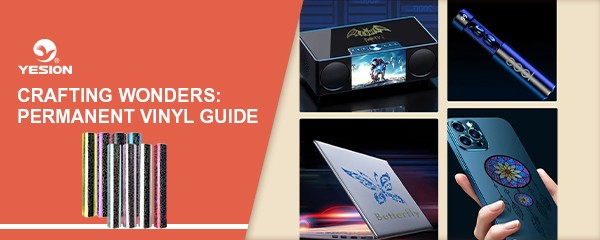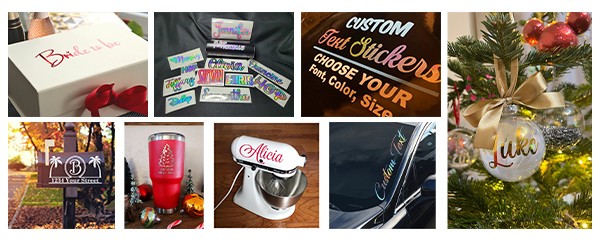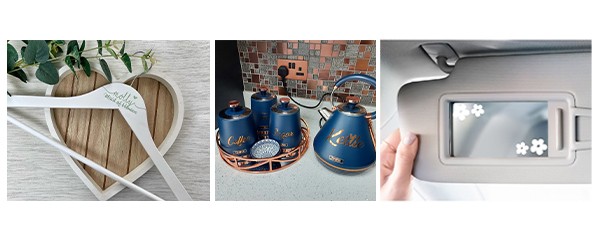
Sparking Creativity: The Art of Adhesive Vinyl
2023-12-26
Everything You Need to Know About Infusible Ink Transfer Sheets
2024-01-03Welcome to our comprehensive guide to permanent vinyl! YESION, as a factory specializing in permanent vinyl production, we are excited to share our expertise and insights on this versatile crafting material. Whether you are a seasoned crafter or just starting out, this guide will provide you with valuable information on techniques, applications, and unleash your artistic potential with permanent vinyl.
What is Permanent Vinyl?
Permanent vinyl is a type of adhesive vinyl that is designed to be long-lasting and durable. It is commonly used in crafting projects where a strong bond is required, and the finished product needs to withstand various conditions, such as outdoor exposure or frequent handling.
Related:
Permanent Adhesive Vinyl: A Comprehensive Guide
Types of Permanent Vinyl
There are various types of permanent vinyl available in the market, each with its own unique characteristics and applications. Some popular options include:
Outdoor Vinyl: This type of permanent vinyl is specifically designed for outdoor use, making it resistant to weather conditions such as rain, sun exposure, and temperature fluctuations. It is ideal for projects like outdoor signs, car decals, and window displays.
Indoor Vinyl: Indoor permanent vinyl is suitable for projects that will be used and displayed indoors. It is less resistant to outdoor elements but still provides long-lasting adhesion. It is commonly used for home decor, personalized mugs, and wall decals.
Glossy Vinyl: Glossy permanent vinyl has a shiny finish that adds a vibrant and polished look to your crafts. It is perfect for creating eye-catching designs on items like tumblers, laptop covers, and phone cases.
Matte Vinyl: Matte permanent vinyl has a non-reflective finish, giving your crafts a more subtle and sophisticated look. It is commonly used for wall art, labels, and personalized gifts.
Patterned Vinyl: Patterned permanent vinyl comes in a variety of designs, allowing you to add flair and personality to your crafts. It is great for creating unique and decorative items like journals, scrapbooks, and party decorations.
YESION Holographic rainbow gradient color adhesive craft vinyl
More videos about YESION adhesive vinyl application, please visit the YOUTUBE channel.
Tools and Materials for Working with Permanent Vinyl
To work with permanent vinyl effectively, you will need a few essential tools and materials:
Cutting Machine: A cutting machine, such as a Cricut or Silhouette, is essential for cutting intricate designs and shapes out of permanent vinyl.
Weeding Tools: Weeding tools, such as a weeding hook or tweezers, are used to remove the excess vinyl from your design after cutting.
Transfer Tape: Transfer tape is used to transfer your cut vinyl design from its backing onto your desired surface.
Related:
Choosing the Best Transfer Tape for Vinyl
Scraper or Burnishing Tool: A scraper or burnishing tool helps to smooth out the vinyl and remove any air bubbles during the application process.
Cleaning Supplies: Before applying permanent vinyl, it is crucial to clean the surface thoroughly to ensure proper adhesion. You may need cleaning solutions, lint-free cloths, or rubbing alcohol, depending on the surface you are working with.
Techniques and Applications of Permanent Vinyl
Techniques for Working with Permanent Vinyl
Working with permanent vinyl requires some basic techniques to ensure a successful and professional-looking outcome. Here are some essential techniques to keep in mind:
Surface Preparation: Before applying permanent vinyl, make sure the surface is clean, dry, and free from dust or debris. This will ensure proper adhesion and longevity of the vinyl.
Cutting and Weeding: Use a cutting machine, such as a Cricut or Silhouette, to cut your desired design or shape from the permanent vinyl. After cutting, carefully weed out the excess vinyl using a weeding tool, leaving only the desired design on the backing sheet.
Transfer Tape Application: Transfer tape is used to transfer the vinyl design from the backing sheet to the desired surface. Apply the transfer tape over the weeded vinyl design, ensuring it adheres evenly. Then, carefully peel off the backing sheet, leaving the vinyl design on the transfer tape.
Applying the Vinyl: Place the transfer tape with the vinyl design onto the prepared surface. Use a squeegee or a credit card to firmly press down the vinyl, ensuring proper adhesion. Slowly and carefully peel off the transfer tape, leaving the vinyl design on the surface.
Applications of Permanent Vinyl
Permanent vinyl can be used in a wide range of crafting projects. Here are some popular applications:
Home Décor: Create personalized wall decals, quotes, or designs to enhance the aesthetic appeal of your home. You can also use permanent vinyl to customize items like picture frames, mirrors, and furniture.
Personalized Gifts: Add a personal touch to gifts by creating customized labels, mugs, tumblers, or keychains. Permanent vinyl allows you to create unique and memorable gifts for your loved ones.
Party Decorations: Make your parties or events truly special with custom banners, signs, and decorations. Permanent vinyl can be used to create personalized party favors, wine glasses, or even temporary tattoos.
Organization and Labeling: Keep your spaces organized and clutter-free by using permanent vinyl for labeling containers, storage bins, and pantry items. It adds a neat and professional touch to your organization efforts.
Maintaining and Caring for Permanent Vinyl Projects
To ensurethe longevity of your permanent vinyl projects, it’s important to follow proper care and maintenance guidelines. Here are some tips:
Hand-Washing: If your project is a drinkware item or any item that may come in contact with water, it’s best to hand-wash it. Avoid soaking the vinyl in water for extended periods or using abrasive cleaning tools that can damage the vinyl.
Avoid Extreme Heat: While permanent vinyl is generally heat-resistant, it’s best to avoid exposing it to extreme heat sources like direct sunlight or heat from a dishwasher. Prolonged exposure to heat can cause the vinyl to warp or peel.
Gentle Cleaning: When cleaning your permanent vinyl projects, use a mild soap or gentle cleaning solution. Avoid harsh chemicals or abrasive cleaners that can damage the vinyl. Gently wipe the surface with a soft cloth or sponge.
Storage: If you need to store your permanent vinyl projects, keep them in a cool and dry place, away from direct sunlight. Avoid storing them in areas with high humidity or extreme temperature changes, as this can affect the adhesive and overall quality of the vinyl.
Troubleshooting Common Issues
Sometimes, you may encounter common issues when working with permanent vinyl. Here are some troubleshooting tips:
Vinyl not Sticking: If the vinyl is not sticking properly, ensure that the surface is clean and dry before applying the vinyl. You can also try applying more pressure with a squeegee or credit card when adhering the vinyl.
Vinyl Peeling: If the vinyl starts to peel after application, it may be due to insufficient pressure during application. Use a squeegee or credit card to firmly press down the vinyl and ensure proper adhesion.
Bubbles or Wrinkles: If you notice bubbles or wrinkles under the vinyl, gently lift the affected area and reapply, smoothing out any air bubbles or wrinkles as you go. Take your time and work slowly to achieve a smooth surface.
Transfer Tape Issues: If you’re having trouble with the transfer tape not properly adhering to the vinyl or not releasing the vinyl onto the surface, try using a fresh piece of transfer tape or adjust the pressure when applying the transfer tape.
Permanent vinyl is a versatile and exciting crafting material that allows you to bring your creative visions to life. With the right techniques, applications, and care, you can create stunning and professional-looking projects that will impress others. Remember to experiment, have fun, and explore the endless possibilities that permanent vinyl offers.
Related:
Common Issues with Adhesive Vinyl Applications
19 Mistakes to Avoid When Using Adhesive Vinyl: A Comprehensive Guide



